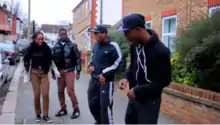Azonto
Azonto is a dance and music genre from Ghana.[1] Ghana News Agency cites their study which found out the dance is connected to the traditional Ga dance Kpanlogo, associated with the coastal towns in the country such as Chorkor, James Town, Teshie, Nungua and Tema, in the Greater Accra Region.[2]
 An Azonto move | |
| Inventor | Several individuals |
|---|---|
| Origin | Ghana |
Several accounts say Azonto was formerly known as 'Apaa' in these communities.[3] The Apaa dance, hence Azonto dance, involves a set of hand movements that either mimic everyday activities especially ones concerning people's livelihoods,[4] or moves that are meant to amuse an audience.
It began with one- or two-step movements but has been advanced to more complex and almost acrobatic movements.[5] Just like most African dances, Azonto involves knee bending and hip movements. The dance has effectively evolved from a few basic moves to miming actions such as ironing of clothes, washing, driving, boxing, praying, swimming, and others.[6]
History
Azonto is a communicative dance believed to originate from "Apaa" which literally means to work. Apaa was used to show the profession of an individual. The azonto dance has since grown further to relay coded messages. The dance later got into the minds of most Ghanaians. In the same year (2013),[7] most Ghanaian music videos were full of Azonto dance and later spread to most African countries and other parts of the world.[8][9]
Popular music researcher Jesse Weaver Shipley claims that like hiplife, the popularity of Azonto is a direct result of its interactions in diaspora. Azonto[1] is identified with Ghanaian indigeneity by those abroad and with cosmopolitanism by those at home"[10]
International popularity
Azonto can be traced as far back as one of R2Bees upcoming songs "Azonto" but was rejuvenated by Guru's Lapaz Toyota and later the producer NshonnaMusick with the song "You Go Kill Me" which had Sarkodie (rapper) and EL (rapper) on it. It was later popularized on social media by the music videos that portrayed the dance form with fast-pace tempos, home-made dance instructional videos uploaded on YouTube with no commercial intent, and group choreographers done by mostly Ghanaians and other African nationals living in UK, Germany and U.S.[11]
Following the worldwide interest in the Ghana's Azonto dance, and the name of Azonto itself being used for a variety of entertaining activities, such as Azonto Petroleum,[12] the Azonto Ghana Commission was created to organise the Ghana's most populous arts and entertainment (Azonto) and also use the Commission as a department to support groups or individuals using the Azonto dance and other form to promote Ghana, peace and unity among people from all walks of life.
Tracks
| Track Title | Artiste | Album Title |
|---|---|---|
| "Lapaz Toyota" | Guru | |
| "You Go Kill Me" | Sarkodie (featuring E.L) | |
| "Dangerous" | Sarkodie | |
| "Zooze" | Koo Maanu (featuring No-Tyme) | |
| "Move To The Gyal Dem" | Donae'o (featuring Sarkodie) | |
| "Aboodatoi" | Gasmilla | |
| "Chop Kenkey" | Joey B | |
| "Twame Lala" | Stay Jay | |
| "Obuu Mo" | E.L | |
| "Kaluu" | E.L | |
| "Yenko Nkoaa" | Eduwodzi (featuring Stay J) | |
| "Azonto" | Fuse ODG (featuring Itz Tiffany) | |
| "Kolom" | Buk Bak | |
| "Sokode" | Keche | |
| "Body Lotion" | Keche | |
| "Azonto Ghost" | Bisa Kdei | |
| "Aluguntugui" | Keche | |
| "Moko Ni" | 4x4 | |
| "Antenna" | Fuse ODG | |
| "Seke" | Dr Slim (featuring Double) | |
| "Ayi" | Criss Waddle (featuring Bisa Kdei) | |
| "Azonto" | Wizkid | |
| '"Azonto'' | R2BEES |
See also
References
- "Ghana's new dance craze - the Azonto". BBC News. Archived from the original on 2019-05-01. Retrieved 2019-04-30.
- "Ghana’s Azonto Dance hit global entertainment stage". ghananewsagency.org. Archived from the original on 2015-04-05. Retrieved 2020-04-29.
- "Azonto - The New Music and Dance Craze in Ghana". Modern Ghana. Archived from the original on 2020-04-01. Retrieved 2020-04-29.
- Mark, Monica (3 September 2012). "Ghana's Azonto craze takes over dancefloors across the world". The Guardian. Retrieved 29 April 2020.
- Aidoo, Kwame. "The Best Places to Learn the Azonto Dance in Ghana". Culture Trip. Archived from the original on 2019-05-01. Retrieved 2019-05-01.
- Stephen Atta Owusu (4 February 2012). "Azonto - The New Music and Dance Craze in Ghana". modernghana.com. Archived from the original on 16 April 2013. Retrieved 19 June 2013.
- "Ghana's new dance craze - the Azonto". BBC News. Archived from the original on 2019-05-01. Retrieved 2019-05-01.
- "Could Ghana's new Azonto dance craze take over the world?" Archived 2016-03-10 at the Wayback Machine BBC News, 18 June 2012.
- Chigozie, Emeka (2015-05-11). "What Is Azonto? - Dance, Music, Songs, Meaning". Answers Africa. Archived from the original on 2019-05-01. Retrieved 2019-05-01.
- Shipley, J. W. (2013), "Transnational circulation and digital fatigue in Ghana's Azonto dance craze", American Ethnologist, 40 (2): 362–381, doi:10.1111/amet.12027
- Monica Mark (3 September 2012). "Ghana's Azonto craze takes over dancefloors across the world". The Guardian. Archived from the original on 3 February 2014. Retrieved 29 August 2013.
- "Ghana | Bongo Exclusive". Bongo Exclusive. Archived from the original on 2018-05-02. Retrieved 2018-05-02.
- "Top 10: Songs That Put Azonto on the Map". Ghana Magazine. Archived from the original on 21 January 2013. Retrieved 27 January 2013.
- "GC Music Chart: Top 10 Songs Of The Week". GhanaCelebrities.com. 2012-03-11. Archived from the original on 2013-06-09. Retrieved 27 January 2013.
